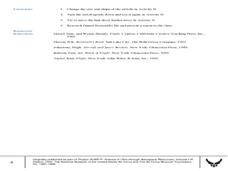Curated OER
Design of Airfoil for Given Lift
Students use FoilSim to design an airplane wing that generates a given lift. As they change parameters such as airspeed, altitude, angle of attack, thickness and curvature of the airfoil, and size of the wing area, the software...
Curated OER
An Uplifting Experience
Fifth graders conduct flight experiments. In this uplifting experience lesson plan, 5th graders build an airfoil and place in a variety of conditions to observe the results of lift and force in flight, as well as angle of attack....
Curated OER
Introduction to Flight: A Math, Science and Technology Integrated Project
Seventh graders review graphing procedures and practice locating points using x,y coordinates. Students calculate the areas of the top and bottom surfaces of the airfoil. They construct a test model of the airfoil.
Curated OER
Boomerangs Keep Coming Back
Students investigate the flight of paper boomerangs. In this flight lesson, students examine the flight variables of paper boomerangs, which they make, by investigating the concepts of lift and drag. They examine what happens when an...
Curated OER
Design of Airfoils and Problem- Solving Using FoilSim
Ninth graders, after reading the explanation given below, complete the problem-solving activities to demonstrate an understanding of the concepts presented.
Curated OER
Lift Relationships
Students use FoilSim (downloadable) to determine how lift is affected by varying parameters on the Airfoil simulation.
Curated OER
Actual Airflow vs. Ideal Airflow: Stalls
Learners use 3-D modeling techniques to observe the characteristic signature of the stall condition apparent on an airfoil at high angles of attack. They use FoilSim to compare the above with ideal airflow.
Curated OER
Airplane Wings
Students examine the aerodynamics of a wing and how it generates lift. In this flight lesson students complete several experiments including how to build a paper plane and how airfoils affect performance.
Curated OER
Upside-Down Wings
Young scholars use FoilSim to demonstrate that the graphic analysis of the airflow around one object can be used to hypothesize airflow graphs for objects as they are elongated from a sphere to an airfoil shape.
Curated OER
Paper Airplane Activity
Ninth graders select and build one of five different paper airplane designs and test them for distance and for time aloft. Part of this activity is designed to explore NASA developed software, FoilSim, with respect to the lift of an...
Curated OER
100 Years of Flight
Students investigate Bernoulli's principle of air pressure and how it
relates to the lift of an airplane. Students identify various Aeronautical vocabulary terms. Students construct a paper glider and experiment with the control surfaces...
Curated OER
Wingin' It
Learners investigate the physics of flight by creating an airfoil. In this physics lesson, students create an airplane wing from copy paper, cardboard, bamboo skewers and other classroom items. Learners compete with their...
Curated OER
Mass & Velocity Effect
Students, after reading the explanation given below, use FoilSim to complete the activity to fulfill the specifications of a given airfoil and then plot and interpret graphs.
Curated OER
Wind Gauges
Students use FoilSim interactive software to become familiar with the way in which the flow of air across or around an airfoil affects its ability to create lift.
Curated OER
Wing Specifications
Ninth graders use FoilSim to fulfill the specifications of a given airfoil (wing) and plot and interpret graphs.
Curated OER
Using 3-D Models for Code Validation with FoilSim
High schoolers use FoilSim to complete the activity to create tables of data sets comparing the lift values for a 3-D model of a symmetrical wing section to the values predicted by the FoilSim software.
Curated OER
Flying Tube
Students investigate how a spinning paper tube generates lift as it travels forward.
WindWise Education
How Does a Windmill Work?
Can my windmill pick up a weight? Given the same set of materials, groups design and build the most efficient windmill. On the first day, groups concentrate on getting a windmill to spin, while on the second day, they modify their...
WindWise Education
Which Blades Are Best?
If I change the length, will they work better? After brainstorming the variables of wind turbine blade design, groups choose one variable to isolate and test. The groups then present their data to the class in order for all to have the...
WindWise Education
How Does a Generator Work?
I get a charge out of this. In order to learn how a generator works, groups build and test one in this ninth activity of the series. The generators are tested at low speed and high speed to determine the watt output and whether they have...
WindWise Education
How Can I Design Better Blades?
Small groups use information they have learned about blade construction to design, build, and test their own concepts. The teams compete in order to determine which design has the best average power output.
Curated OER
Investigating Velocity Effects at Takeoff
Young scholars use, with increasing confidence, problem-solving approaches to investigate and explain mathematical content. They make and test conjectures. They use tables and graphs as tools to interpret expressions, equations, and...
Curated OER
Glide Away
Learners design and construct a gliding aircraft. They use the Internet as a research tool to gain background information about specific flight principles.
Curated OER
Lift and Launch Angle
Young scholars engage in a hands-on experiment to determine how launch angles affect airflow around the wing of an aircraft. They view a series of photographs and read information describing the Wright Brothers' experiences. They...























